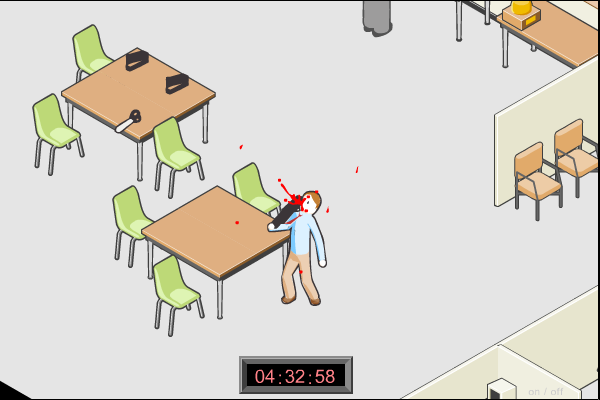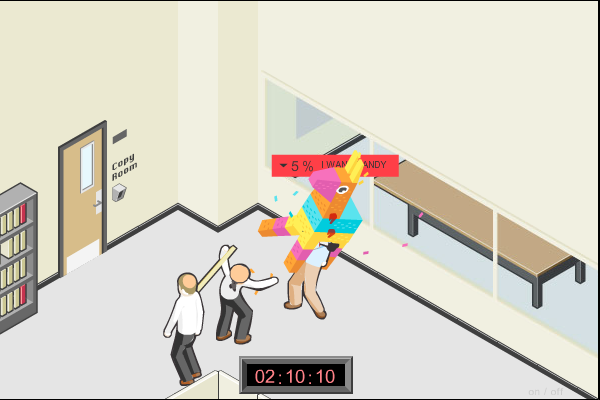Retro Replay Review
Gameplay
Five Minutes to Kill (Yourself) delivers an unconventional action experience by challenging players to inflict as much self-damage as possible within a strict five-minute countdown. You control your beleaguered cubicle worker using arrow keys to traverse rooms, corridors, and the break room, while the spacebar serves as your primary interaction button. Every object you encounter—from office staplers to questionable breakroom pastries—can become a tool for self-harm, either directly or by combining with other items. This unique twist on time-attack gameplay keeps you on your toes, as you balance riskier, high-damage combos against the ticking clock.
(HEY YOU!! We hope you enjoy! We try not to run ads. So basically, this is a very expensive hobby running this site. Please consider joining us for updates, forums, and more. Network w/ us to make some cash or friends while retro gaming, and you can win some free retro games for posting. Okay, carry on 👍)
Interacting with coworkers adds a layer of strategic depth. By selecting the correct dialogue options during brief conversations, you can provoke them into delivering a beating that racks up significant damage. Learning which conversation paths yield the most severe brawls becomes a mini-puzzle in itself. Meanwhile, environmental hazards—such as loose floor tiles or malfunctioning copiers—serve as stage props for self-destructive antics. Navigating these hazards cleverly can yield high scores, but each misstep might waste precious seconds or leave you with less time to explore other high-value damage sources.
The crafting system in Five Minutes to Kill (Yourself) is deceptively simple yet surprisingly deep. Finding a lighter and a can of spray allows you to improvise a makeshift flamethrower, while combining a party hat and pinata stick turns any celebration into a self-punishment fiesta. This encourages exploration, as you’ll scour every nook in search of items that can be fused into more potent weapons. The map interface, accessible at any time, not only pinpoints your current location but also tracks the cumulative damage you’ve sustained, helping you prioritize your next move under the relentless countdown.
Finally, the real draw of the gameplay lies in its replayability. Each five-minute run feels like a frantic puzzle where you refine routes, discover new object combinations, and perfect dialogue triggers. Leaderboards and optional daily challenges push you to optimize every second, whether you’re aiming for the most creative self-inflicted demise or simply trying to beat your previous damage total. This fast-paced loop of trial, error, and mastery keeps the experience fresh long after multiple playthroughs.
Graphics
Visually, Five Minutes to Kill (Yourself) opts for a stylized, cartoon-inspired aesthetic that balances dark humor with approachable, low-poly character models. The office setting is instantly recognizable—gray cubicles, flickering fluorescent lights, and scattered paperwork—but the exaggerated animations and vibrant color accents ensure the tone stays light enough for those with a taste for twisted comedy. Character expressions range from zombie-like daze to cartoonish shock, reinforcing the absurdity of the premise.
Environmental details are cleverly designed to reward exploration. Small cracks in walls hint at hidden shortcuts, while coffee-stained floor tiles often conceal useful items like broken scissors or malfunctioning staples. Animations are fluid when you combine items or interact with coworkers, giving a satisfying heft to every improvised weapon swing or self-inflicted blow. The rapid pace of the action never stutters, even when multiple effects and physics simulations play out in close quarters.
The user interface is clean and unobtrusive, with a minimalistic health tracker and countdown timer displayed at the screen’s edges. The map overlay is easy to navigate, with distinct icons for interactive objects and coworkers. Color-coding helps you quickly differentiate between low-damage hazards (marked in yellow) and high-damage opportunities (marked in red), so you spend fewer precious seconds deciphering the interface and more time executing daring self-harm combos.
Subtle visual flourishes—like the camera briefly shaking on high-impact hits—add a cinematic feel to your demise without coming across as gratuitous. Sound design complements the visuals with comical “boink” effects, muffled yelps, and whimsical background tunes that underscore the game’s irreverent tone. Together, these graphical and auditory elements create an engaging atmosphere that both amuses and challenges players.
Story
At its core, Five Minutes to Kill (Yourself) presents a darkly comedic narrative about workplace ennui and corporate frustration. You play as an overworked office drone who, feeling trapped in a cubicle labyrinth, decides to turn the tables—on himself. While there’s no deep branching storyline, each run unravels a bit more of the protagonist’s gallows humor through snippets of dialogue and environmental storytelling: sticky notes of resignation speeches, passive-aggressive memos from management, and motivational posters that border on the absurd.
The lack of a conventional story arc is intentional; instead, the game conveys its message through the sheer absurdity of your mission. Every stapler thrust into your hand and every spurt of blood reinforces the satire of a work culture that “consumes” its employees. Talking to coworkers reveals brief slice-of-life vignettes—some sympathetic, others hostile—that round out the world without slowing down the action. It’s a quick, punchy narrative that complements the five-minute runtime.
While there’s no hidden lore tucked away in notebooks or elaborate cutscenes, optional dialogue choices hint at backstories for a handful of quirky NPCs: the perpetually nervous receptionist, the lunchtime conspiracy theorist, and the supply closet hoarder who guards foam pointers like precious relics. These interactions add personality to the run-and-gun self-harm spree, giving you small narrative rewards for exploring every conversational branch.
Ultimately, this minimalist storytelling approach keeps the focus on gameplay while delivering a biting critique of modern office life. You finish each session with more than just a new high score—you come away with a wry smile, appreciating the game’s dark humor and social commentary, even as you laugh at the gory absurdity of your own digital demise.
Overall Experience
Five Minutes to Kill (Yourself) is a whirlwind of dark humor, frantic gameplay, and surprisingly strategic depth compressed into bite-sized sessions. It stands out for its audacious premise and relentless pacing, making every minute count as you scramble to maximize your self-inflicted damage. Fans of time-attack challenges and quirky action titles will find themselves hooked on the “just one more run” loop, especially as they unlock new item combinations and learn every dialogue shortcut.
The game’s balance of accessibility and depth is a major strength. Newcomers can pick it up quickly—mastering arrow-key movement and the spacebar interact—but veterans can dive deep into crafting the most efficient damage routes and memorizing coworker responses. Leaderboard competition and daily challenges provide additional incentives to keep refining your tactics and exploring all four floors of the office building.
Some players might find the premise a bit too macabre, but the cartoonish visuals and tongue-in-cheek writing keep the tone firmly in the realm of satire. What could have been gratuitously gory instead feels like a playful, over-the-top parody of workplace frustration. The five-minute constraint is both a creative limitation and a brilliant design choice, ensuring that the experience never outstays its welcome.
In summary, Five Minutes to Kill (Yourself) offers a refreshingly offbeat action game that’s as engaging as it is irreverent. Its fast-paced runs, clever item combinations, and darkly humorous world make it an excellent pick for anyone looking for a short but memorable gaming experience. Whether you’re chasing high scores, laughing at its comedic violence, or simply appreciating the satire, this title leaves a lasting impression in just five frantic minutes.
 Retro Replay Retro Replay gaming reviews, news, emulation, geek stuff and more!
Retro Replay Retro Replay gaming reviews, news, emulation, geek stuff and more!









Reviews
There are no reviews yet.